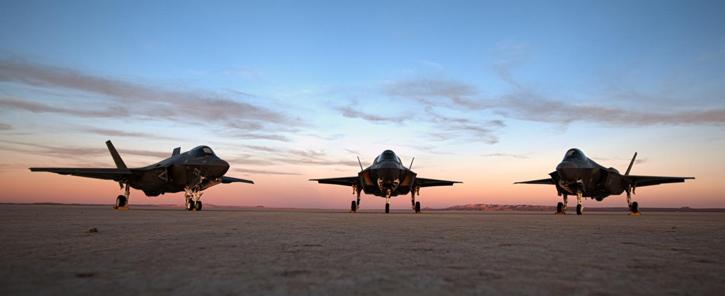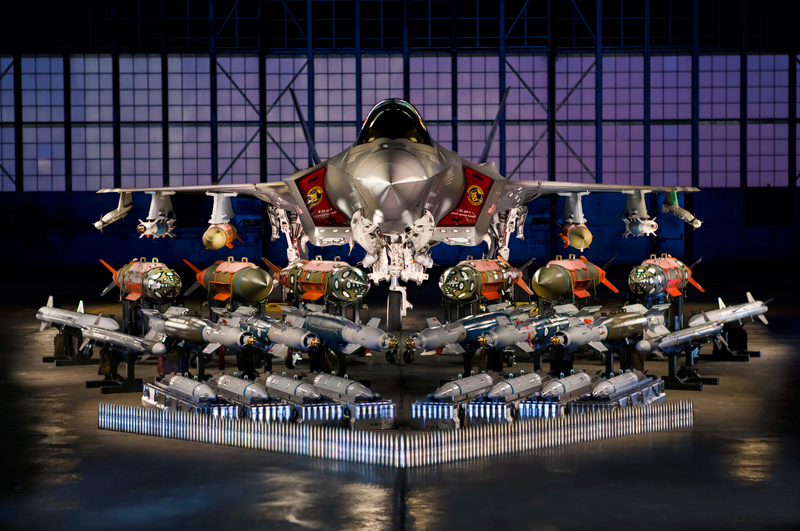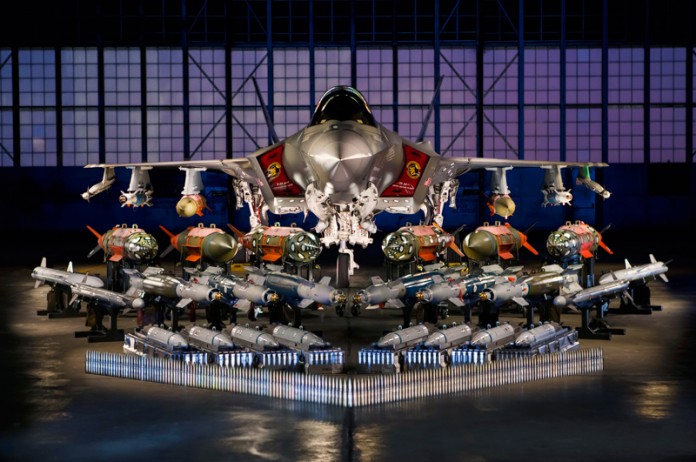
The F-35 is on course toward full weapon certification this year, Lockheed Martin announced. “All three variants of the F-35 Lightning II continue on a path toward full weapons certification, by successfully completing numerous milestones during the previous four months.” The company said in a press release.
Among the weapons tests performed recently are AIM-120 (AMRAAM) and AIM-132 ASRAAM air/air missiles. The AMRAAM test was performed at supersonic speed for the first time, completing separation testing needed for the Block 2B milestone. The air/ground tests included delivery of JDAM and GBU-39 Small Diameter Bomb. The air/ground weapon delivery missions included separation tests of a GBU-39 and full engagement of two targets designated with coordinates delivered by the F-35 integral Electro-Optical Targeting System (EOTS) – the first test involving the new targeting system developed especially for the F-35.
“The weapons development program continues to track forward on the plan laid out by the Technical Baseline Review approved in 2010,” said Lt. Gen. Chris Bogdan, F-35 Program Executive Officer. “All weapons tests needed for 2B software, the software the U.S. Marine Corps will use to declare IOC, is complete and will be ready to go for their combat capability certification.”
Marine Corps F-35B IOC shall be declared when the first operational squadron is equipped with 10-16 aircraft, and US Marines are trained, manned, and equipped to conduct CAS, Offensive and Defensive Counter Air, Air Interdiction, Assault Support Escort, and Armed Reconnaissance in concert with Marine Air Ground Task Force resources and capabilities. Based on the current F-35 JPO schedule, the F-35B will reach the IOC milestone between July 2015 (Objective) and December 2015 (Threshold). The Air Force F-35A will reach the IOC milestone in August-December 2016. The US Navy’s F-35C is expected to accomplish this task between August 2018 and February 2019.

Most of the current activities are focused on the initial weapons configurations prepared as part of the Marine Corps’ Initial Operational Capability planned for July 2015. The aircraft completed day and night mission Effectiveness evaluation of the Close Air Support (CAS) mission, one of the critical tasks required for the Marine Corps F-35 Block 2B mission software. The tests also included day and night missions flown with Gen III helmet mounted display, developed for the fourth version of the next phase software block – 3IR4.
Additional weapons are due for integration at later stages. Among these is the FAU-22 four-barrel gun. Preparations for flight testing are due to begin mid-year at Edwards AFB, Calif., and will include ground fire tests, muzzle calibration, flight test integration and in-flight operational tests. The 25mm missionized gun pod carried externally, centerline mounted on the F-35B and F-35C also begins testing this year to meet U.S. service’s desired schedule for full warfighting capability software known as 3F. The Block 3F software is currently planned for delivery with the Low Rate Initial Production nine (LRIP 9) U.S. aircraft in 2017. Absence of a gun as part of the F-35B weapons was claimed as a major flaw, due to the Marines’ need for close air support for ground forces.
Activities accomplished in the past four months included validating 2B weapons software and successfully executing several weapons separation and engagement tests. “The most recent accomplishments are in support of the first military service Initial Operational Capability (IOC) declaration by the U.S. Marine Corps in July.” The announcement said.
The services are also beginning to integrate the aircraft into weapons and tactics planning. The first F-35 was delivered yesterday (January 15, 2015) to the Weapons School’s at Nellis AFB, Nevada where it will be used to drive tactics and curriculum development for the Weapons School’s first F-35 course.
The F-35 program has surpassed 25,000 combined flight hours in December with F-35 military fleet aircraft (16,200 hours) nearly doubling the System Development and Demonstration (SDD) test aircraft (8,950) hours.





















